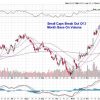1. Relative Strength Index (RSI)
Described as a momentum oscillator, the Relative Strength Index (RSI) is a widely used indicator in technical analysis to measure the speed and change of price movements. Developed by J. Welles Wilder, the RSI ranges from 0 to 100 and is typically used to identify overbought or oversold conditions in a security. Traders often look for divergence between the RSI and price action to anticipate potential reversals in the market.
2. Moving Average Convergence Divergence (MACD)
The Moving Average Convergence Divergence (MACD) is a trend-following momentum indicator that shows the relationship between two moving averages of a security’s price. Traders utilize the MACD by looking for crossovers between the MACD line and the signal line, as well as the distance between the two lines which can indicate the strength of a trend. The MACD histogram is also a valuable tool for visualizing the divergence between the MACD line and the signal line.
3. On-Balance Volume (OBV)
Developed by Joseph Granville, On-Balance Volume (OBV) is a cumulative indicator that takes into account trading volume to predict price movements. The premise behind OBV is that volume precedes price movements, so changes in volume can provide insights into the direction of a security. Traders often compare OBV with price action to confirm the strength of a trend.
4. Average True Range (ATR)
The Average True Range (ATR) is a technical indicator that measures the volatility of a security by analyzing the range between the high and low prices over a specified period. The ATR is valuable for traders as it helps assess the potential risk and reward of a trade based on the historical volatility of a security. A higher ATR value implies greater volatility, whereas a lower value suggests a more stable price movement.
5. Accumulation/Distribution Line
The Accumulation/Distribution Line is a volume-based indicator that aims to gauge the flow of money into or out of a security. Developed by Marc Chaikin, this indicator considers both the price and volume of a security to provide insights into the buying and selling pressure in the market. Traders use the Accumulation/Distribution Line to confirm trends and anticipate potential reversals based on the divergence between the indicator and price action.
—
This article provides an insightful overview of five essential breadth indicators for traders and investors alike. By understanding the nuances and applications of these indicators, market participants can make more informed decisions in navigating the complexities of the financial markets.




























